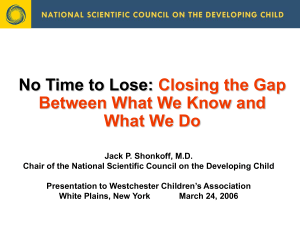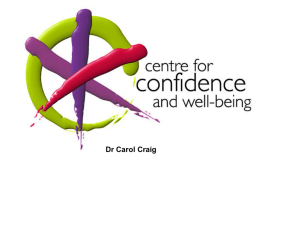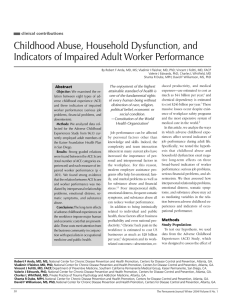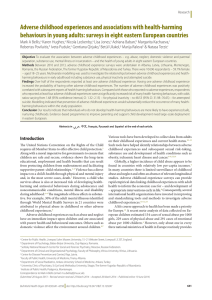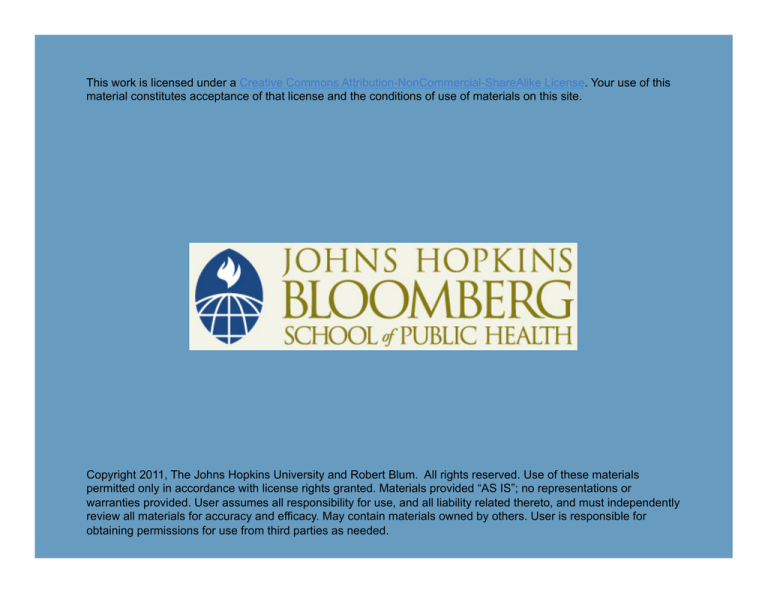
This work is licensed under a Creative Commons Attribution-NonCommercial-ShareAlike License. Your use of this
material constitutes acceptance of that license and the conditions of use of materials on this site.
Copyright 2011, The Johns Hopkins University and Robert Blum. All rights reserved. Use of these materials
permitted only in accordance with license rights granted. Materials provided “AS IS”; no representations or
warranties provided. User assumes all responsibility for use, and all liability related thereto, and must independently
review all materials for accuracy and efficacy. May contain materials owned by others. User is responsible for
obtaining permissions for use from third parties as needed.
Section C
The Contexts That Affect Early Child Development
The Contexts That Impact Early Child Development
Parental attachment
Family mental illness
Absent parent
Maternal depression
3
Adverse Childhood Experiences Are Common
Source: CDC.
Household dysfunction
Substance abuse
Parental separation/divorce
Mental illness
Battered mother
Criminal behavior
27%
23%
17%
13%
6%
Abuse
Psychological
Physical
Sexual
11%
28%
21%
Neglect
Emotional
Physical
15%
10%
4
Adverse Childhood Events and Depression
5
Poverty
Poverty adversely impacts child development (one in four children)
Child outcomes
Risk for poor relative
to non-poor children
Lead poisoning
3.5
Birth to unmarried teenager
3.1
Short-stay hospital episode
2.0
Grade repetition and high school dropout
2.0
Low birth weight
1.7
Mortality
1.7
Learning disability
1.4
Parent report of emotional or behavior
problem that lasted 3 months or more
1.3
SES mediators
Child abuse and neglect
6.8
Depression
2.3
Experiencing violent crimes
2.2
Substance abuse
1.9
Source: Shonkoff and Phillips. (2000).
6
Adverse Childhood Events and Adult Substance Abuse
7
Adverse Events and Adult Ischemic Heart Disease
8
What Do We Know about Programs?
What makes a difference?
Day Care
High-quality* child care improves ECD
- Linguistic development
- Cognitive development
- Social development
- Academic achievement
*High-quality refers to the quality of transactions between providers and children
10
Perry Preschool Project (High Scope)
At ages 3 and 4, 123 low income, low-IQ, African-American children
randomized into intervention and control (1962–1967)
Intervention was High Scope’s Participatory Learning Approach
11
Perry Preschool Program
12
The Nurse Home Visit Program (D. Olds)
Targeted low-income, unwed pregnant women
Randomized controlled study with four arms
Screenings for children at 12 and 24 months
Screenings plus free child care through 24 months
Same as 2 plus home visits prenatally
Same as 3 plus home visits through 24 months
13
Outcomes of Nurse Home Visit Program
Through age 4: fewer trips to the ED
Through the age of 15: less child abuse
At age 15: fewer arrests, fewer convictions, fewer sexual partners,
less smoking, less alcohol use
Source: Olds et al. (1998).
14

